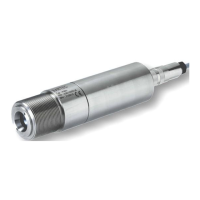Annex
A - 70
Operating Instructions Radiation sensors R3XX
In practice, it is a good idea to verify the E factor once by taking a
comparison measurement. Various measurement procedures may be
suitable depending on the circumstances.
Drill hole method:
A hole with a depth of 2 - 3 mm is drilled into the measurement object and
an immersion measurement is taken in the hole using a low-mass sensor
(semiconductor or thermal element, 0.5 mm). Then, the temperature is
measured using a radiation sensor and the E factor is adjusted until the “true
temperature” determined beforehand is displayed.
Emission conversion:
The surface of the measurement object is covered with a substance for
which the E factor is known (e.g. black 3M "Velvet Coating 2010" matt
varnish; E 0.93).
You can also apply this method if you want to measure the surface
temperature of shiny rollers (E 0.2). Usually, it is possible to apply the
adhesive matt varnish at the edge of this isothermally heated calendar.
If this is not possible, or if the temperature distribution across the roller
length is irregular, you should use what is called an emission converter, like
the one shown in the picture. In the process, a thin black Teflon strip (E
0.95) stretched on a frame makes contact with the roller and is measured
using the radiation sensor.
Taking a measurement on a slow-running roller with the aid of the emission
converter:
Contact-based measurement:
Measure the surface temperature of the measurement object, for instance
using a low-mass thermal spiral or band element. This method cannot be
used for substances with a very poor thermal conductivity, though.
Convection measurement:
If it is not possible to take a contact-based measurement because the
measurement object is moving extremely quickly (as may be the case for a
calendar or roller, for instance), a roller sensor that works based on the
convection principle can be used. The large time constant of the sensor
must be taken into account but it does not interfere with this one-off
measurement.
Test method:
If you blacken part of a material sample (e.g. with Velvet Coating from 3M)
and then, for instance, heat it up in a climatic test cabinet, you can take a
differential measurement to establish the exact value of the emission factor.
In other words, with the E factor set to 1, you take a measurement on the
blackened part and then take a measurement on the part that has not been
blackened. By changing the E factor, you set the same display as before and
can now read the E factor on the E regulator.

